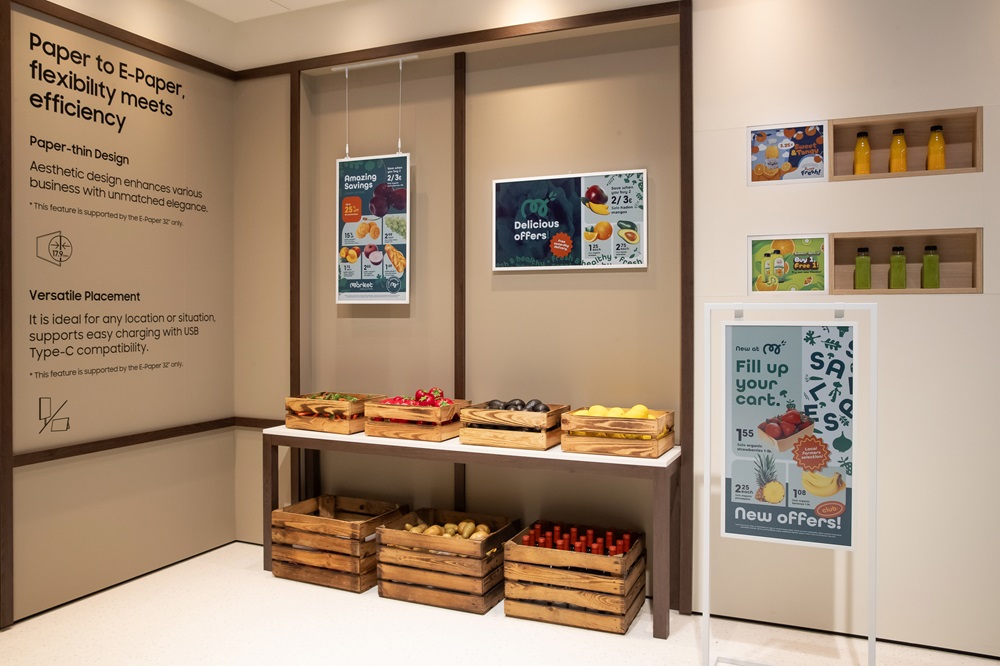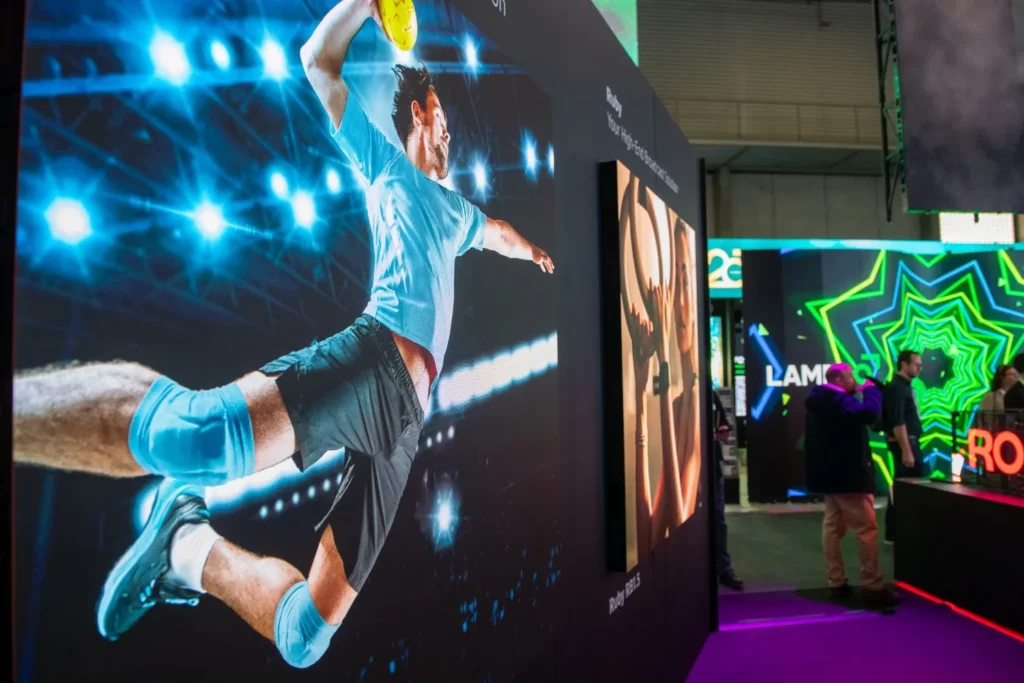LED remains the standard
LED continues to dominate digital signage, offering even better quality and innovative design. Transparent LED screens stole the show, from mesh structures that make content appear to float in mid-air to ultra-thin displays. This technology is a game-changer for storefronts and interior displays, with increasingly sustainable and flexible applications.
A trade show like ISE isn’t complete without showstoppers and mesmerizing LED installations. Samsung’s 462-inch The Wall media facade demonstrated that LED has no limits, while AI-generated artwork on PPDS screens showcased the future of true-color LED – the first displays to be both Pantone Validated and Pantone Skintone Validated. But the ultimate highlight? The waterfall installation by LANG featuring MUXWAVE’s transparent mesh solution.
E-Paper gains ground
E-paper is ready for broader adoption in retail. As an energy-efficient alternative to paper, it seamlessly combines sustainability with cost savings. While color reproduction and pricing remain challenges, the technology is advancing rapidly.
At the fair, we saw standard sizes of 13- and 32-inch screens already available this year, along with experimental 55- and even 75-inch outdoor models. Samsung, for instance, is testing a hybrid variant combining an LCD color layer with e-paper for outdoor displays. The colors are still somewhat limited, but given the current pace of development, improvements are just around the corner. These innovations make e-paper increasingly attractive for retailers looking for subtle, sustainable signage solutions.

The store as a smart ecosystem
IoT and remote management are making retail smarter and more efficient. More and more electronic devices in stores are being integrated into a unified smart system, turning every store into a Smart Store. Samsung’s SmartThings Pro plays a key role in this, alongside Nexmosphere’s advanced sensor technology. The result? Fewer technical issues, lower energy consumption, and a personalized shopping experience.
For example, with cloud integration, screens automatically dim when no customers are nearby, and signage content adjusts in real-time based on visitor behavior. Smart Stores are becoming more sustainable while simultaneously improving the customer journey.
AI: from hype to reality
Artificial Intelligence was the hot topic leading up to ISE 2025. Once just a buzzword, AI now delivers tangible applications that redefine digital signage. Samsung integrated AI into its latest displays to optimize energy consumption and enhance user experiences.
Creative AI
At the Digital Signage Summit, a conference within ISE organized by invidis, AI’s role in the industry was explored in depth. Various applications were showcased, including generative content and digital shopping assistants.
One of the highlights was the session ‘The Next Frontier: Digital Humans and Generative AI in Retail Digital Signage,’ which demonstrated how AI-powered brand ambassadors can create a more personalized shopping experience. By balancing generative and custom-made content, brands can achieve both scalability and exclusivity. Customization techniques such as pixel mapping and projection mapping enhance immersion and engagement.

Sustainability as a non-negotiable
Green promises are no longer enough – sustainability is a necessity. Retailers demand proof that their digital signage solutions are energy-efficient and responsible. Brands are responding en masse with energy-saving displays and remote management systems that reduce on-site maintenance and minimize energy waste.
E-paper and transparent LED are making major strides, while Sharp/NEC’s new LED wall repurposes waste heat for more efficient lighting. Meanwhile, Samsung and LG are heavily investing in smart content management systems that optimize screen usage remotely.
Sustainability isn’t just an obligation – it’s a smart business case. Lower energy consumption means reduced costs and improved performance. Green numbers? Now they’re doubly positive.
Conclusion
ISE 2025 confirmed that digital signage in retail is becoming smarter, more sustainable, and more dynamic. LED remains the gold standard, e-paper is gaining traction, and AI is driving interactive, personalized content. At the same time, IoT is transforming stores into smart ecosystems where everything is connected.
For retailers, the message is clear: innovation isn’t about radical revolutions, but about smart evolutions. The future of digital signage is here – and it’s more exciting than ever.
